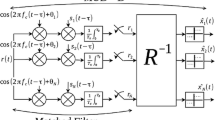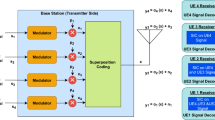Abstract
Focusing on enriched multimedia broadcast/multicast opportunities of a wireless communication network, we build a multicast cell configuration in a CDMA-based network. In a CDMA-based wireless network, a terminal can significantly reduce the bit error rate by the combining of data streams from multiple base stations. To combine the data streams, multiple base stations have to be operated with a common time schedule. The cells whose base stations are operated as such are called soft-combine cells. A terminal can take advantage of error rate reduction, if the terminal is in a soft-combine cell and at least one neighbor cell supports soft-combine. Our problem is to find a limited number of soft-combine cells under the heavy computational burden of a network controller, such that the benefit of the soft-combine is maximized.






Similar content being viewed by others
References
Broadcast-Multicast Service (BCMCS) (2003). Framework Draft Document, 3GPP2.
CDMA2000 High Rate Broadcast-Multicast Packet Data Air Interface Specification, 3GPP2 TSG-C SWG2.5, August 18, 2003.
Wang, J., Sinnarajah, R., Chen, T., Wei, Y., & Tiedemann, E. (2004). Broadcast and multicast services in cdma2000. IEEE Communications Magazine, 42(2), 76–82.
3GPP TS 22.146 Multimedia Broadcast/Multicast Service: Stage1, 3GPP, March 2003.
Boni, A. et al. (2004). Multimedia broadcast multicast service—technology overview and service aspects. Fifth IEE International Conference on 3G Mobile Communication Technologies.
Tatesh, S., & Palat, S.K. (2004). Future evolution of 3G networks. International Conference on Information and Communication Technologies: From Theory to Applications.
Kim, J. H., & Kim, K. S. (2006). Optimal construction of soft-combine zone in a multicast CDMA network. Istanbul: ICC.
Kim, J. H.,& Kim, K. S. (2005). Dynamic soft-combine zone configuration in a multicast CDMA network, Globecom, St. Louis.
3GPP TR 25.803 S-CCPCH performance for MBMS, September 2005.
Garey, M. R., & Johnson, D. S. (1979). Computers and intractability: A guide to the theory of NP-completeness. San Francisco: W.H. Freeman.
Balakrishnan, A., Magnanti, T. L., & Wong, R. T. (1989). A dual-ascent procedure for large-scale uncapacitated network design. Operations Research, 37, 716–740.
Erlenkotter, D. (1978). A dual based procedure for uncapacitated facility location. Operations Research, 26, 992–1009.
Wong, R. T. (1984). A dual ascent approach for Steiner tree problems on a directed graph. Mathematical Programming, 28, 271–287.
Holma, H., & Toskala, A. (2000) WCDMA for UMTS. Wiley.
Author information
Authors and Affiliations
Corresponding author
Rights and permissions
About this article
Cite this article
Kim, JH. Concentrated multicast zone configuration in CDMA network systems. Wireless Netw 16, 57–63 (2010). https://doi.org/10.1007/s11276-008-0114-5
Published:
Issue Date:
DOI: https://doi.org/10.1007/s11276-008-0114-5




